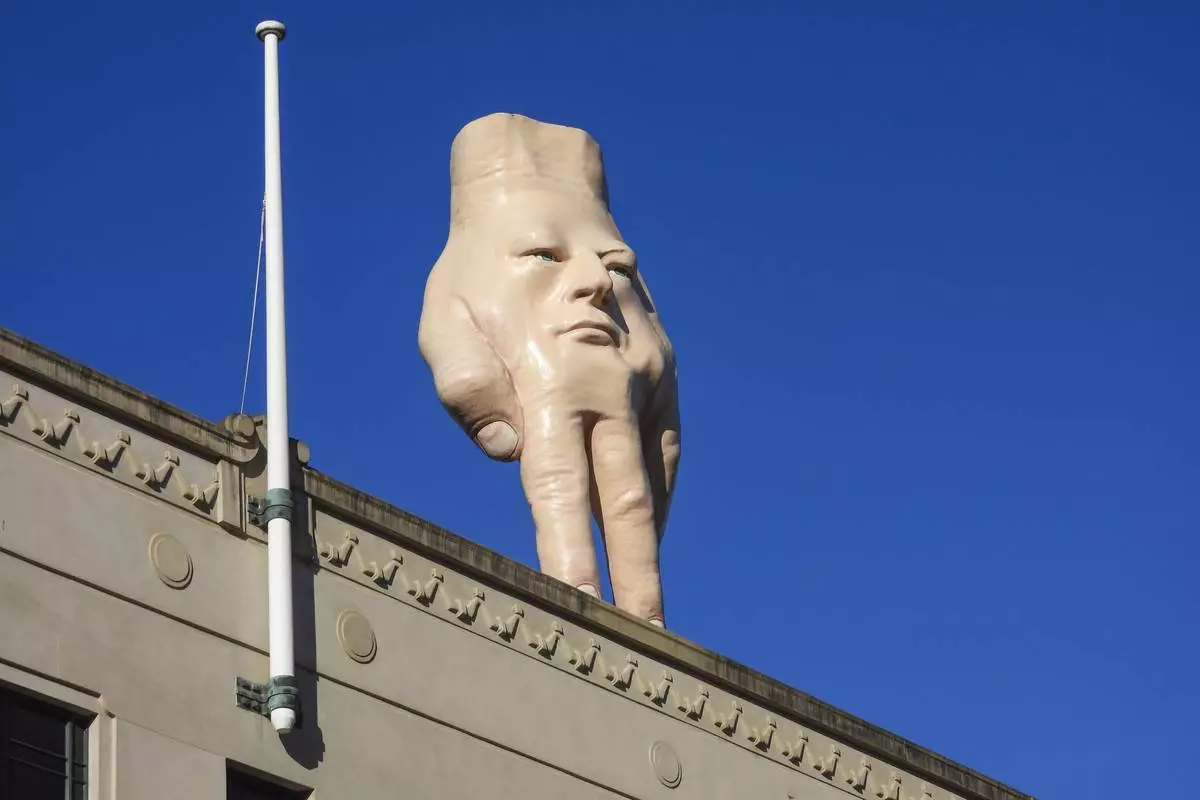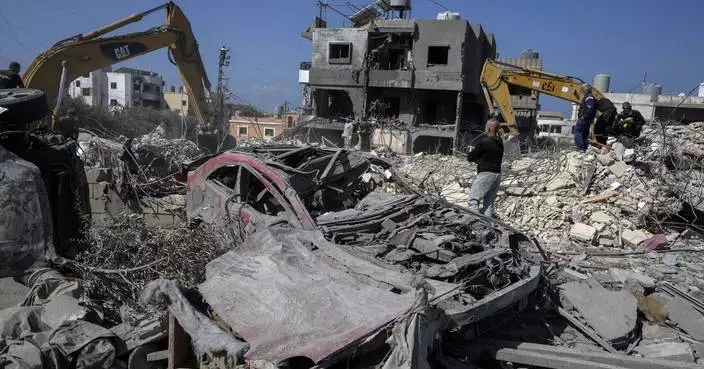WELLINGTON, New Zealand (AP) — Perched on two fingers on the roof of an art gallery in Wellington, New Zealand, the giant sculpture of a hand has loomed over the city for five years.
Named Quasi, the 16-foot — almost 5 meters — creation of Australia-based sculptor Ronnie van Hout bears an unsmiling human face — because why not?
Some found it disturbing, and now, after five years of provoking controversy and myriad emotions — from horror and revulsion to delight — among residents of New Zealand’s capital, Quasi will be removed from the roof of City Gallery this week.
It will be taken to a new home, the gallery said Wednesday.
“This is either a great day for Wellington or a terrible day for Wellington and there’s not much view in between,” said Ben McNulty, a Wellington city council member.
Personally, McNulty told The Associated Press he felt “devastated” by the sculpture’s departure.
Quasi is made of steel, polystyrene and resin, and was based on scans of van Hout’s hand and face. It was named in part for Quasimodo, the bellringer in Victor Hugo’s 1831 novel “The Hunchback of Notre-Dame.”
Hence the male gender some have attributed to Quasi.
Quasi first graced — or haunted — an art gallery in Christchurch, New Zealand, in 2016 but proved polarizing. It was the subject of an op ed in the local newspaper listing reasons the sculpture “must go,” including claims that one of its outstretched fingers “appears to be inappropriately and belligerently pointing at pedestrians and office workers.”
“Perhaps the monster just wants to be loved?” van Hout responded at the time.
In 2019, Quasi was installed in Wellington, where he grew over time on its residents.
“He arrived and I won’t say the city unanimously hated him but I reckon 80% were like, ‘What is this monster? What have we done?’” McNulty said.
“But I think that over time there’s been a bit of a softening, there’s sort of a pro-Quasi group, which I consider myself part of,” he added.
On Wednesday, many at Wellington’s Civic Square, where the gallery with Quasi is located, said they had warmed to him too.
“It’s really disturbing but it’s a staple of Wellington now,” said Anja Porthouse, who had brought friends and family to see Quasi and was “gutted” it was leaving.
Quasi is to be lifted from the roof by helicopter on Saturday, when the giant hand will travel to an undisclosed location in Australia, the gallery said.
“Everything comes to an end eventually,” van Hout told the AP. “I am sure it will be missed, but even Lovecraftian nightmares have to return to where they came from, and now you only have an absence to reflect on.”
Dozens responded to the news on social media with dismay, glee and jokes about the curse that local lore has attributed to Quasi being lifted.
The sculpture has adorned the Wellington skyline during “some of its most difficult times,” McNulty said. The city has struggled with earthquake-prone buildings, widespread plumbing problems and political division in recent years.
Other comments took guesses about where Quasi might end up.
“He’s going to The Hague,” wrote one New Zealander on X.
“He will be missed,” said Jane Black, who heads the Wellington Sculpture Trust.
“I’ll personally be pleased to see it head somewhere else for a change,” the city's mayor, Tory Whanau, told the AP. “I think there’s a strong feeling of relief.”

A 16-foot- ( almost 5 meters ) tall hand sculpture named Quasi stands perched on its fingertips atop the roof of an art gallery in Wellington, New Zealand, Wednesday, Oct. 30, 2024. (AP photo/Charlotte Graham-McLay)

A 16-foot- ( almost 5 meters ) tall hand sculpture named Quasi stands perched on its fingertips atop the roof of an art gallery in Wellington, New Zealand, Wednesday, Oct. 30, 2024. (AP photo/Charlotte Graham-McLay)

A 16-foot- ( almost 5 meters ) tall hand sculpture named Quasi stands perched on its fingertips atop the roof of an art gallery in Wellington, New Zealand, Wednesday, Oct. 30, 2024. (AP photo/Charlotte Graham-McLay)

A 16-foot- ( almost 5 meters ) tall hand sculpture named Quasi stands perched on its fingertips atop the roof of an art gallery in Wellington, New Zealand, Wednesday, Oct. 30, 2024. (AP photo/Charlotte Graham-McLay)
WASHINGTON (AP) — Some 8,000 North Korean soldiers are now in Russia near Ukraine’s border and are preparing to help the Kremlin fight against Ukrainian troops in the coming days, the Biden administration said Thursday.
The new figure is a dramatic increase from a day earlier, when Defense Secretary Lloyd Austin would only say “some” of the troops had moved toward Ukraine’s border in the Kursk region, where Moscow's forces have struggled to push back a Ukrainian incursion.
That also would mean most of the North Korean troops that the U.S. and its allies say have been sent to Russia are now on the Russia-Ukraine border.
The U.S. has estimated a total of about 10,000 North Korean troops are in Russia. Seoul and its allies assessed that the number has increased to 11,000, while Ukraine has put the figure higher, at up to 12,000.
Of the 8,000 in Kursk, “we’ve not yet seen these troops deploy into combat against Ukrainian forces but we would expect that to happen in the coming days,” Secretary of State Antony Blinken said at a news conference with Austin and their South Korean counterparts.
He said Russia has been training North Korean soldiers in artillery, drones and “basic infantry operations, including trench clearing, indicating that they fully intend to use these forces in front line operations.”
North Korea’s move to tighten its relationship with Russia has raised concerns around the world about how that may expand the war and what Russian military aid will be delivered in exchange.
It’s become a key topic as U.S. and South Korean leaders met this week in Washington, fueling concerns that the presence of those soldiers will further destabilize the Asia-Pacific and broaden Moscow’s war on Ukraine.
South Korean Foreign Minister Cho Tae-yul condemned the deployment “in the strongest possible terms” and called for an immediate withdrawal of the troops. North Korea’s belligerent actions not only places the European continent but also the Korean peninsula under threat and that Seoul agrees “to take necessary measures accordingly,” he said.
Austin reiterated that Moscow has provided the North Korean troops with Russian uniforms and equipment, another indication they are likely to be used on the front lines.
“Make no mistake, if these North Korean troops engage in combat or combat support operations against Ukraine they would make themselves legitimate military targets,” Austin said.
However he said the injection of North Korean troops was unlikely to cause Ukraine to lose ground in Kursk.
“This 10,000 won’t come close to replacing the numbers that the Russians have lost” in their fighting to date, Austin said. The U.S. estimates that more than 500,000 Russian forces have been killed or wounded in the more than two-year long conflict. The U.S. has provided more than $59 billion in military aid to help Ukraine fend off Russia, and Austin pledged Thursday that another aid package would be announced soon.
The U.S. and South Korean leaders called out China to engage, saying Beijing should be deeply concerned by the movements and the possibility it will further destabilize the region.
“If China is serious about its desire for de-escalation, it should be asking Russia some hard questions at this point and whether it intends to broaden this conflict by this kind of behavior,” Austin said.
There are questions about what new military technologies North Korea might get from Russia in exchange for the deployment and whether it might lead other nations to send their own forces to fight in the war.
North Korea test-fired an intercontinental ballistic missile Thursday for the first time in almost a year, demonstrating a potential advancement in its ability to launch long-range nuclear attacks on the American mainland. Some experts speculated that Russia may have provided technological assistance to North Korea over the launch.
As the meeting in Washington was underway, the U.S., South Korea and Japan released a joint statement condemning the missile launch as a “flagrant violation” of numerous U.N. Security Council resolutions and criticizing the deepening military cooperation between North Korea and Russia, particularly the deployment of the North Korean troops.
“We strongly urge (North Korea) to immediately cease its series of provocative and destabilizing actions that threaten peace and security on the Korean Peninsula and beyond,” they said.
In a dramatic moment during a U.N. Security Council meeting earlier Thursday, the deputy U.S. ambassador to the United Nations, Robert Wood, first noted the number of North Korean troops near Ukraine.
“And I have a very respectful question for my Russian colleague: does Russia still maintain that there are no DPRK troops in Russia? That’s my only question and final point,” he said.
Russia's deputy ambassador to the U.N., Anna Evstigneeva, did not respond to the comment at the meeting called by Moscow to discuss international peace and security. The session was then adjourned.
Besides troops, North Korea also has provided munitions to Russia, and earlier this month, the White House released images it said were of North Korea shipping 1,000 containers of military equipment there by rail.
Lederer reported from the United Nations. Associated Press writers Kim Tong-hyung in Seoul, South Korea, and Illia Novikov in Kyiv, Ukraine, contributed to this report.

Defense Secretary Lloyd Austin, left, speaks during a joint press briefing with South Korean Defense Minister Kim Yong Hyun, right, at the Pentagon on Wednesday, Oct. 30, 2024 in Washington. (AP Photo/Kevin Wolf)

FILE - Russian President Vladimir Putin, left, and North Korea's leader Kim Jong Un pose for a photo during a signing ceremony of the new partnership in Pyongyang, North Korea, on June 19, 2024. (Kristina Kormilitsyna, Sputnik, Kremlin Pool Photo via AP, File)

South Korean Defense Minister Kim Yong Hyun speaks during a joint press briefing with Defense Secretary Lloyd Austin at the Pentagon on Wednesday, Oct. 30, 2024 in Washington. (AP Photo/Kevin Wolf)

Defense Secretary Lloyd Austin smiles during a joint press briefing with South Korean Defense Minister Kim Yong Hyun at the Pentagon on Wednesday, Oct. 30, 2024 in Washington. (AP Photo/Kevin Wolf)

Defense Secretary Lloyd Austin, left, speaks during a joint press briefing with South Korean Defense Minister Kim Yong Hyun, right, at the Pentagon on Wednesday, Oct. 30, 2024 in Washington. (AP Photo/Kevin Wolf)

Defense Secretary Lloyd Austin, right, welcomes South Korean Defense Minister Kim Yong Hyun, left, to the Pentagon on Wednesday, Oct. 30, 2024 in Washington. (AP Photo/Kevin Wolf)



















